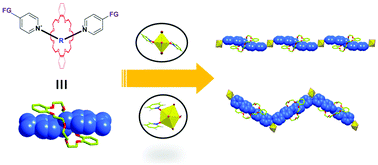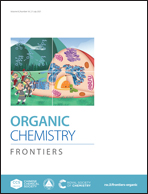Coordination-driven assembly of actinide-organic polyrotaxanes involving crown ether macrocycles†
Abstract
Research on synthesizing new coordination-driven polyrotaxanes as well as regulating their structural diversity contributes to the success of macrocycle-based supramolecular materials. In this work, we describe the synthesis of a new kind of actinide-organic polyrotaxane involving crown ether macrocycles for the first time. Crystal structures of two uranyl polyrotaxane compounds, UCER-1 and UCER-2, as well as a third non-polyrotaxane compound UON-1, have been determined, and the formation mechanism of actinide-organic polyrotaxanes is discussed in terms of factors affecting the assembly process. A comparison of the reaction conditions and the corresponding outcomes suggests the necessity of a host–guest pseudorotaxane linker for the successful construction of targeted actinide-organic polyrotaxanes. The coordination of different coordination atoms, especially bromide ions and uranyl ions, is analyzed in detail through theoretical calculations. As an extension of cucurbituril-based uranyl-organic polyrotaxanes, the introduction of crown ether macrocycles as a new supramolecular element brings a different kind of actinide polyrotaxane with intriguing molecular structures and supramolecular assembly behaviours, and will, we believe, expand the research scope of actinide rotaxane coordination polymers.

- This article is part of the themed collection: Macrocycle-based Supramolecular Elements


 Please wait while we load your content...
Please wait while we load your content...